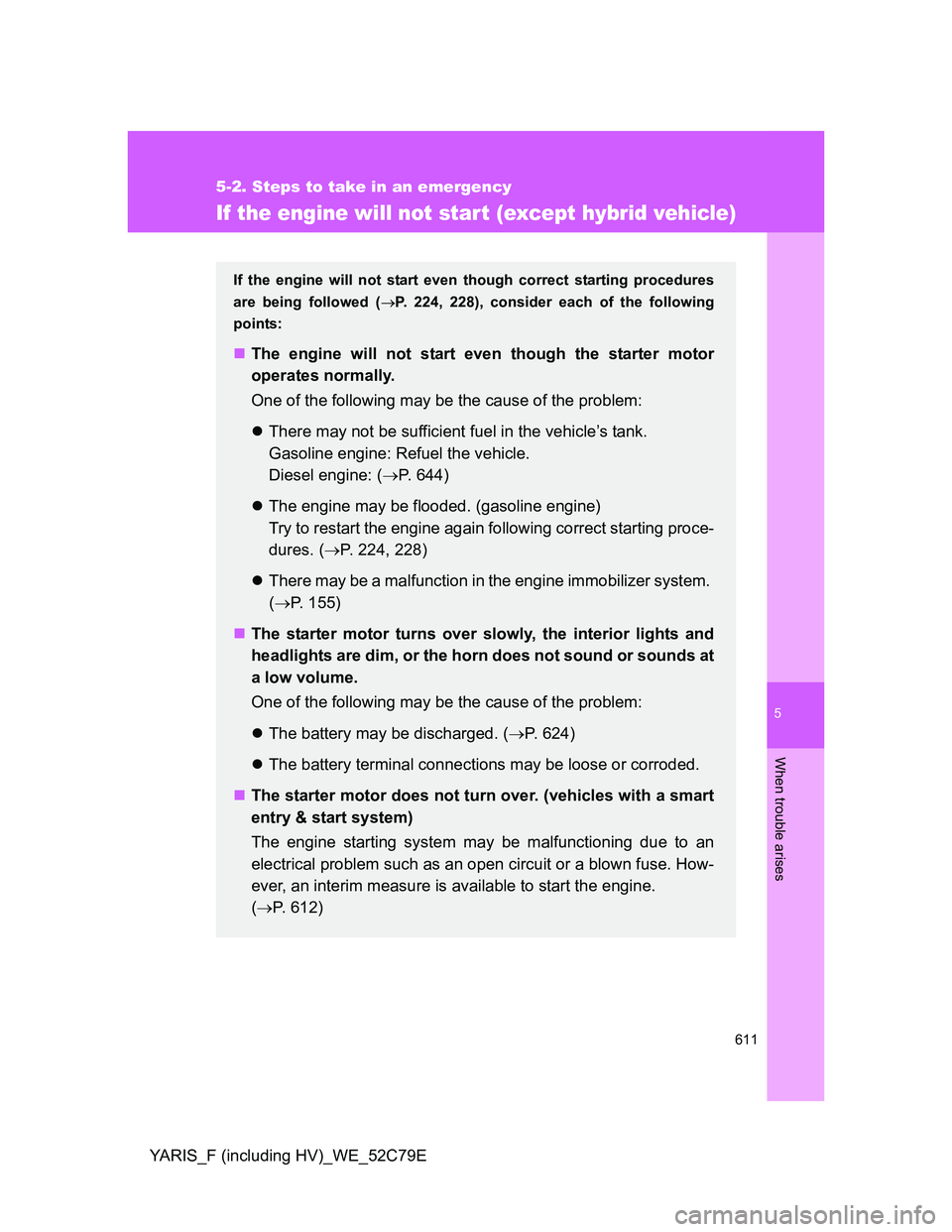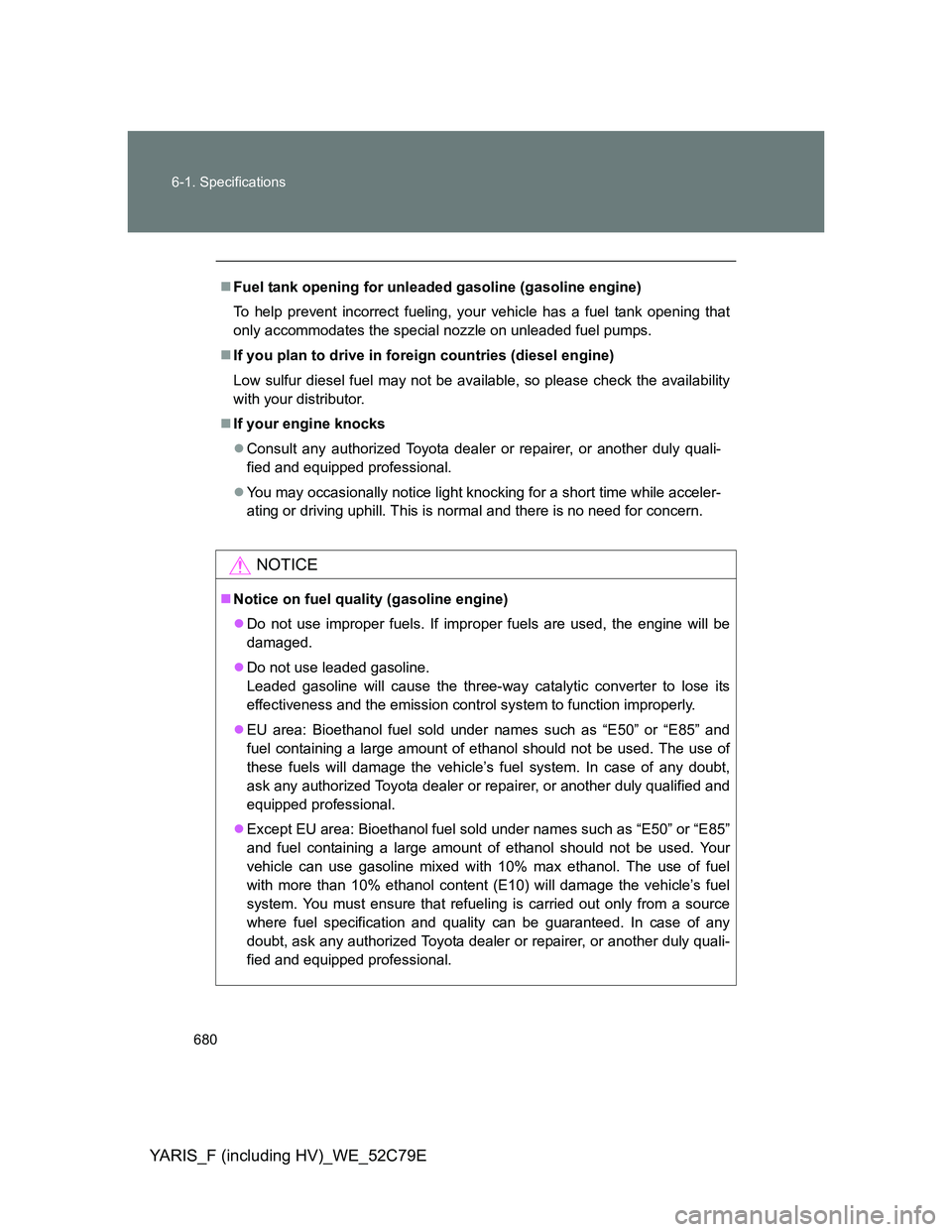Page 152 of 704
152 1-6. Refueling
YARIS_F (including HV)_WE_52C79E
Closing the fuel tank cap
After refueling, turn the fuel tank
cap until you hear a click. Once
the cap is released, it will turn
slightly in the opposite direction.
Turn the fuel tank cap slowly
to open.
Fuel types
Gasoline engine
EU area:
Unleaded gasoline conforming to European standard EN228, Research
Octane Number of 95 or higher
Except EU area:
Unleaded gasoline, Research Octane Number of 95 or higher
Page 153 of 704

153 1-6. Refueling
1
Before driving
YARIS_F (including HV)_WE_52C79E
Diesel engine
EU area:
Diesel fuel conforming to European standard EN590
Except EU area:
Diesel fuel that contains 50 ppm or less of sulfur and has a cetane number of
48 or higher
Use of ethanol blended gasoline in a gasoline engine
Toyota allows the use of ethanol blended gasoline where the ethanol content
is up to 10%. Make sure that the ethanol blended gasoline to be used has a
Research Octane Number that follows the above.
CAUTION
When refueling the vehicle
Observe the following precautions while refueling the vehicle. Failure to do
so may result in death or serious injury.
After exiting the vehicle and before opening the fuel door, touch an
unpainted metal surface to discharge any static electricity. It is important to
discharge static electricity before refueling because sparks resulting from
static electricity can cause fuel vapors to ignite while refueling.
Always hold the grips on the fuel tank cap and turn it slowly to remove it.
A whooshing sound may be heard when the fuel tank cap is loosened.
Wait until the sound cannot be heard before fully removing the cap. In hot
weather, pressurized fuel may spray out the filler neck and cause injury.
Do not allow anyone that has not discharged static electricity from their
body to come close to an open fuel tank.
Do not inhale vaporized fuel.
Fuel contains substances that are harmful if inhaled.
Page 611 of 704

5
611
5-2. Steps to take in an emergency
When trouble arises
YARIS_F (including HV)_WE_52C79E
If the engine will not start (except hybrid vehicle)
If the engine will not start even though correct starting procedures
are being followed (P. 224, 228), consider each of the following
points:
The engine will not start even though the starter motor
operates normally.
One of the following may be the cause of the problem:
There may not be sufficient fuel in the vehicle’s tank.
Gasoline engine: Refuel the vehicle.
Diesel engine: (P. 644)
The engine may be flooded. (gasoline engine)
Try to restart the engine again following correct starting proce-
dures. (P. 224, 228)
There may be a malfunction in the engine immobilizer system.
(P. 155)
The starter motor turns over slowly, the interior lights and
headlights are dim, or the horn does not sound or sounds at
a low volume.
One of the following may be the cause of the problem:
The battery may be discharged. (P. 624)
The battery terminal connections may be loose or corroded.
The starter motor does not turn over. (vehicles with a smart
entry & start system)
The engine starting system may be malfunctioning due to an
electrical problem such as an open circuit or a blown fuse. How-
ever, an interim measure is available to start the engine.
(P. 612)
Page 680 of 704

680 6-1. Specifications
YARIS_F (including HV)_WE_52C79E
Fuel tank opening for unleaded gasoline (gasoline engine)
To help prevent incorrect fueling, your vehicle has a fuel tank opening that
only accommodates the special nozzle on unleaded fuel pumps.
If you plan to drive in foreign countries (diesel engine)
Low sulfur diesel fuel may not be available, so please check the availability
with your distributor.
If your engine knocks
Consult any authorized Toyota dealer or repairer, or another duly quali-
fied and equipped professional.
You may occasionally notice light knocking for a short time while acceler-
ating or driving uphill. This is normal and there is no need for concern.
NOTICE
Notice on fuel quality (gasoline engine)
Do not use improper fuels. If improper fuels are used, the engine will be
damaged.
Do not use leaded gasoline.
Leaded gasoline will cause the three-way catalytic converter to lose its
effectiveness and the emission control system to function improperly.
EU area: Bioethanol fuel sold under names such as “E50” or “E85” and
fuel containing a large amount of ethanol should not be used. The use of
these fuels will damage the vehicle’s fuel system. In case of any doubt,
ask any authorized Toyota dealer or repairer, or another duly qualified and
equipped professional.
Except EU area: Bioethanol fuel sold under names such as “E50” or “E85”
and fuel containing a large amount of ethanol should not be used. Your
vehicle can use gasoline mixed with 10% max ethanol. The use of fuel
with more than 10% ethanol content (E10) will damage the vehicle’s fuel
system. You must ensure that refueling is carried out only from a source
where fuel specification and quality can be guaranteed. In case of any
doubt, ask any authorized Toyota dealer or repairer, or another duly quali-
fied and equipped professional.
Page 704 of 704
704
YARIS_F (including HV)_WE_52C79E
GAS STATION INFORMATION
Auxiliary catch lever
P. 462Fuel filler door
P. 151
Hood lock release lever
P. 462
Fuel filler door opener
P. 151Tire inflation pressure
P. 672
Fuel tank capacity (Reference)1KR-FE, 1NR-FE and 1ND-TV engines
42 L (11.1 gal., 9.2 Imp. gal.)
1NZ-FXE engine
36 L (9.5 gal., 7.9 Imp. gal.)
Fuel type P. 660
Cold tire inflation
pressureP. 672
Engine oil capacity
(Drain and refill reference)P. 662
Engine oil type P. 663